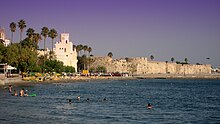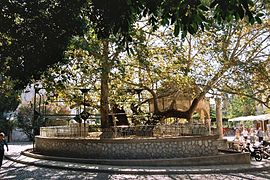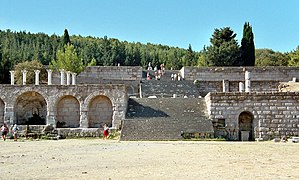Kos
|
Municipality of Kos Δήμος Κω |
||
|---|---|---|
|
|
||
| Basic data | ||
| State : |
|
|
| Region : | South Aegean | |
| Regional District : | Kos | |
| Geographic coordinates : | 36 ° 49 ′ N , 27 ° 7 ′ E | |
| Area : | 290.313 km² | |
| Residents : | 33,388 (2011) | |
| Population density : | 115 people / km² | |
| Seat: | Kos | |
| LAU-1 code no .: | 6401 | |
| Districts : | 3 municipal districts | |
| Local self-government : |
6 boroughs |
|
| Location in the South Aegean region | ||
The Greek island of Kos ( Greek Κως [ kɔs ] ( f. Sg. ), Turkish İstanköy , Italian Coo ) in the eastern Aegean is off the coast of Asia Minor . Kos is the third largest Dodecanese island after Rhodes and Karpathos . In 2011 the island had 33,388 inhabitants. The main town is the city of the same name, Kos with over 19,000 inhabitants , which forms the tourist and cultural center of the island. Since 2011, the island has also formed a municipality in the South Aegean region and, together with Nisyros, the Kos regional district .
geography
Geographical location
Kos is located in the East Aegean Sea at the entrance to the Gulf of Gökova ( Turkish Gökova Körfezi). North of the city of Kos, the shortest distance to the Bodrum Peninsula (Bodrum Yarımadası) west of the Turkish city of Bodrum is less than five kilometers. The Datça Peninsula is 15 km south. Neighboring islands are Pserimos , four kilometers, and Kalymnos , twelve kilometers to the north . Nisyros is 12 km south and Astypalea about 43 km west.
With an area of 287.611 km², the length is a little more than 42 km and the maximum width almost ten kilometers. The coastline is relatively straight with no notable indentations. In the east, near the south coast, the narrow, up to 846 m high mountain range of the Dikeos massif (Δακαιος) forms the highest point on the island. This mountain range flattens out towards the north and turns into a fertile, agriculturally used plain. To the west of a 1.6 km narrow isthmus lies the Kefalos Peninsula (Κέφαλος χερσόνησος) with the 426 m high mountain Latra (Λάτρα) in the extreme south.
Geologically, the island consists of slate , chalk limestone and tertiary layers, with layers of quaternary volcanic tuffs several meters thick .
climate
| Kos | ||||||||||||||||||||||||||||||||||||||||||||||||
|---|---|---|---|---|---|---|---|---|---|---|---|---|---|---|---|---|---|---|---|---|---|---|---|---|---|---|---|---|---|---|---|---|---|---|---|---|---|---|---|---|---|---|---|---|---|---|---|---|
| Climate diagram | ||||||||||||||||||||||||||||||||||||||||||||||||
| ||||||||||||||||||||||||||||||||||||||||||||||||
|
Average monthly temperatures and rainfall for Kos
Source: Temperatures 1981–1997, precipitation 1982–2002 (PDF; 5.2 MB) Kos weather station;
|
|||||||||||||||||||||||||||||||||||||||||||||||||||||||||||||||||||||||||||||||||||||||||||||||||||||||||||||||||||||||||||||||||||||||||||||||||||||||||||||||||||||
history

The island was colonized by Doric settlers from Epidaurus , who may have brought with them the cult of the healing god Asclepius . Since 546 BC Under Persian control, Kos belonged from approx. 450 BC. To the Attic League and fell to Sparta in 405. In the Hellenistic period, Kos was the seat of a medical school (see also empiricist (medical school) ); Contrary to older assumptions, however, this was not led by Hippocrates of Kos (approx. 460-370 BC), the most famous doctor of antiquity, because at that time there were no medical schools in the strict sense, but doctors were trained exclusively in the apprenticeship system .
This school gained similar prominence through the Asklepiadenid , which doctors are said to have sworn when they started their profession, but this is an unsupported assumption . From the middle of the 4th century until the conquest by Alexander the Great , Kos was under the rule of the Carian Hecatomnids in Halicarnassus , today's Bodrum. 366 BC At the northeastern tip of the island, the new capital Kos, replacing the old Astypalaia (today Kefalos ), was founded and a little later the sanctuary of Asklepios was built on the site of an Apollon grove, which was visited by many foreign guests and patients. Around 300 BC The Babylonian priest and historian Berossos founded the first astrology school in the Hellenic world on Kos , which achieved great prestige. Kos minted its own coins in Greek times, on which Asclepius, the snake and the crab are often depicted.
Kos represented a kind of natural trade connection between the trading power Rhodes and the empire of the Ptolemies and came under the influence of both powers. It was largely self-sufficient, but exported wine and silk; its protected harbor played an important role. In their poems, the poets Herodas and Theokritos provide witty sketches of the life of all strata of urban and rural Kos, from the aristocracy to the slaves.
From the 2nd century BC BC Kos was part of the Roman Empire , later the Byzantine Empire . The island was conquered by the Venetians in 1204 and again by the Byzantines in 1262. They ceded these to the Genoese , who sold them to the Johanniter in 1309 . In 1457 and again in 1523 the knights were threatened by an Ottoman invasion. Many residents were enslaved or left the island with the knights in 1523. This was settled by Turks. The Ottoman Empire ruled Kos for almost 400 years, until the island came under Italian control as Coo in 1912 . Italians were also settled here.
In the company "Eisbär" on October 3, 1943, the German Wehrmacht occupied the island until the end of the war . 3,145 Italian and 1,388 British soldiers were captured. During this operation the Kos massacre of captured Italian officers occurred . In 1947 the Italian Aegean Islands , including Kos, were handed over to Greece.
On the night of July 20 to 21, 2017 at around 1:30 a.m. local time, a seaquake with a magnitude of 6.7 on the moment-magnitude scale occurred , which caused destruction, especially in the capital Kos, with two fatalities and at least 100 injuries demanded. A small tsunami flooded the port.
Refugee crisis
Due to its proximity to the Turkish coast, Kos (also on some neighboring islands, especially Lesbos ) is an important destination for migrants who cross over from the Turkish coast by boat. In connection with the planned construction of a registration center for refugees on Kos, violent clashes broke out between residents and the police in February 2016, as residents fear that tourism, the island's main source of income, will be impaired by the refugees.
With regard to the number of bookings by German tourists, these fears have been confirmed, as bookings by German tourists on Kos and the island of Samos, which is also visited by many refugees, decreased for the summer of 2016, while the total number of bookings for German tourists in Greece rose significantly.
Administration and politics
Since the Greek community reform following the Kapodistrias program in 1997, the island of Kos was divided into three communities with a total of six districts. On January 1, 2011, the Kallikratis program merged the former municipalities of the island into the newly created municipality of Kos ( Dimos Ko Δήμος Κω), the administrative seat is the city of Kos. The previous municipalities form municipal districts, the former municipal districts are municipal districts that elect their own local representatives.
| Parish | Greek name | code | Area (km²) | 2001 residents | Residents 2011 | Townships | location |
| Dikeos | Δημοτική Ενότητα Δικαίου | 640102 | 62.575 | 6.094 | 7.130 | Asfendio, Pyli | |
| Iraklidis | Δημοτική Ενότητα Ηρακλειδών | 640103 | 160.538 | 6,963 | 6,826 | Andimachia, Kardamena , Kefalos | |
| Kos | Δημοτική Ενότητα Κω | 640101 | 67,200 | 17,890 | 19,432 | Kos | |
| total | 6401 | 290.313 | 30,949 | 33,388 | |||
In the local elections in 2010 Konstandinos Kaiserlis, who was not a party to the election, won the runoff election with 53.55% at the head of an electoral alliance of the Democratic Left , making him mayor. In the municipal council do not apply:
- 20 seats on the Alliance of the Democratic Left,
- 9 seats on the socialist PASOK ,
- 2 seats on the conservative Nea Dimokratia and
- One seat each for an independent candidate and the KKE .
Population development
| City district (Δημοτική Κοινότητα) | 1905 | 1947 | 1951 | 1961 | 1971 | 1981 | 1991 | 2001 | 2011 |
|---|---|---|---|---|---|---|---|---|---|
| Asfendio | 1,967 | 2,661 | 2,500 | 2,590 | 1,594 | 1,723 | 2,741 | 3,205 | 4,094 |
| Pyli | 1,291 | 2,018 | 2,092 | 1,883 | 1,508 | 1,816 | 2,630 | 2,889 | 3,036 |
| Andimachia | 2,000 | 2.008 | 2,061 | 1,720 | 1,428 | 1,676 | 2,392 | 2,573 | 2,538 |
| Kardamena | 600 | 1,365 | 1,374 | 1,229 | 1.010 | 1,212 | 1,451 | 1,783 | 1,650 |
| Kefalos | 1.405 | 1,809 | 1,886 | 1,861 | 2,197 | 2,072 | 2,451 | 2,609 | 2,638 |
| City of Kos | 5,789 | 8,684 | 8,863 | 8,904 | 8,913 | 11,851 | 14,714 | 17,890 | 19,432 |
| Kos island | 13,052 | 18,545 | 18,776 | 18,187 | 16,650 | 20,353 | 26,379 | 30,949 | 33,388 |
Attractions
- Remains of the Asclepion of Kos near Platáni, not far from Kos town
- St John's fortress Neratzia in Kos town
- Hippocrates' plane tree in Kos town
- Excavations in Kos town, e.g. B. Agora, Gymnasion , Decumana , House of Europe , Odeon , Casa Romana
- Mandraki port in Kos town
- Mountain village of Zia
- Embros-Therme , a thermal spring in the open sea (in the southeast of the island)
- Alykes salt lake near Tigaki
- abandoned ghost village Agios Dimitrios (near Asfendio)
- abandoned village Palio Pyli with castle ruins
- Remains of the fortress Andimachia , near Kos airport
- Peacock forest (Plaka), near Kos airport
Christos Dikeos Chapel on the Dikeos summit of the Dikeos Mountains
Economy and Infrastructure
The island is known for its long sandy beaches with large hotels, but it also offers the charm of remote villages. The tourism is the main industry.
Agriculture
The fertile plain in front of the Dikeos is used for agriculture. Vegetables and grains as well as grapes , almonds , figs , olives and citrus fruits are grown. In the 1920s, the Italian occupiers tried to improve the water supply. Among other things, they created the Pyli reservoir .
power supply
Since 1994, the Greek state electricity company DEI ( ΔΕΗ ) has been operating an oil power plant near Mastichari . The 100 MW system is also connected to the islands of Tilos and Nisyros in the south and Kalymnos and Pserimos in the north via an undersea cable.
The subsidiary PPC Renewables SA of DEI (ΔΕΗ), together with C.ROKAS SA, a subsidiary of the Spanish energy company Iberdrola Renovables near Kefalos, has been running a wind turbine with a capacity of 4.2 MW since February 2002 . The plant is connected to the oil power station at Mastichari.
environment
In the past, the island's rubbish was collected in rubbish dumps and burned. For some years now, the islanders have also been separating their rubbish for recycling. A few years ago, a sewage treatment plant was built in the southeast of the island.
Many of the beaches have now been awarded the blue flag and have received the international award for sustainability. The beaches are checked at regular intervals for the quality of the water and environmental management. Private environmental campaigns seek further improvements in environmental and animal welfare so that tourists are not deterred by the garbage and the lack of respect for animals.
Air traffic
The airport Kos Hippocrates is served all year round by scheduled flights of Olympic and Aegean Airlines from Athens and Rhodes . During the high season between April and October and occasionally in the low season, charter and low-cost airlines land with holidaymakers from many European countries.
Personalities
- Herakleides of Kos (around 440 BC), doctor and father of Hippocrates
- Hippocrates (around 460 BC – around 370 BC), a famous ancient doctor, was born around 460 BC. Born on Kos.
- Berossos , a Babylonian priest and historian, founded the first astrology school in the Hellenic world on Kos .
- Ptolemy Philadelphos (* 36 BC), son of the Egyptian Queen Cleopatra .
- Apelles , an ancient Greek painter, probably died in Kos.
- The island was also the home of Herodas , who wrote about it: "Kos is lovely, pleasant to live in and rich in water."
- Şükrü Kaya (1882–1959), long-time interior minister and foreign minister of Turkey .
- The father of tennis player Pete Sampras (* 1971) comes from the island.
Honorary citizen
- Klaus Bötig (* 1948), German travel writer
Web links
- Official website of the island of Kos (English, Greek)
- Private information website about Kos . In: Insel-Kos.info
- Private information website about Kos . In: Info-Kos.de
- Kos in the Global Volcanism Program of the Smithsonian Institution (English)
Individual evidence
- ↑ Results of the 2011 census, Greek Statistical Office [ΕΛ.ΣΤΑΤ] ( Memento from June 27, 2015 in the Internet Archive ) (MS Excel; 2.6 MB)
- ↑ Ελληνική Στατιστική Αρχή [ΕΛΣΤΑΤ] (Ed.): Στατιστική Επετηρίδα της Ελλάδος . Statistical Yearbook of Greece 2009 and 2010. Piraeus 2011, p. 47 .
- ↑ Climate table Kos (klimatabelle.info)
- ↑ Vincenzo Di Benedetto : Cos e Cnido. In: Mirko D. Grmek (ed.): Hippocratica - Actes du Colloque hippocratique de Paris 4-9 September 1978. Paris 1980, pp. 97-111, further Antoine Thivel : Cnide et Cos ?: essai sur les doctrines médicales dans la collection hippocratique . Paris 1981 (passim), ISBN 2-251-62021-4 ; see also the review by Otta Wenskus , JSTOR 27688435 .
- ^ Ferdinand Peter Moog: Euripides and medicine (= Cologne contributions to the history and ethics of medicine. Volume 3). kassel university press, Kassel 2017, ISBN 978-3-7376-0340-9 , p. 340.
- ↑ Georges Minois : History of the Future. Düsseldorf / Zurich 1998, p. 86.
- ^ Recent earthquake. Department of Geophysics and Geothermics, University of Athens , July 20, 2017, accessed July 26, 2017 (English, Seismological Records).
- ↑ After a seaquake normality slowly returns to Kos. In: zeit.de . July 22, 2017. Retrieved July 26, 2017 .
- ↑ https://www.zeit.de/news/2017-07/21/erdbeben-zwei-tote-und-viele-verletzt-nach-seebeben-vor-kos-21065402
- ↑ Kos fears to be ruined by refugees. In: Die Welt , February 5, 2016, accessed on July 21, 2017.
- ↑ Travel to Greece in demand - but poor overall summer business. In: Frankfurter Allgemeine Zeitung . May 23, 2016, archived from the original on May 23, 2016 ; accessed on July 21, 2017 .
- ^ Results of the local elections on the website of the Greek Ministry of the Interior
- ↑ Plaka Kos
- ↑ Rokas Group Wind Farms in Operation ( Memento from December 14, 2009 in the Internet Archive )
- ↑ Beaches receive a blue flag
- ↑ Tips on sustainability on vacation on Kos
- ^ Gunnar Decker: Notes from Venice. In: New Germany . July 23, 2011, accessed May 1, 2017 .













